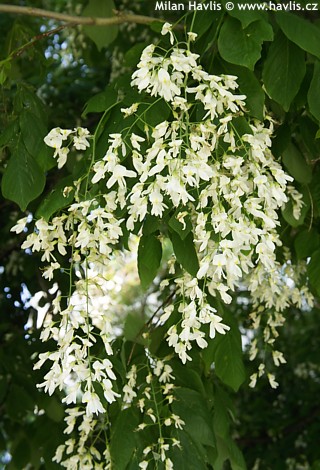Cladrastis kentukea (c.lutea)

Cladrastis kentukea (c.lutea)
yellow wood
yellow wood
| SIZE/TYPE | medium-sized tree |
|---|---|
| USUAL HEIGHT | 5-10m |
| USUAL WIDTH | |
| LEAVES | deciduous broadleaf |
| COLOUR OF LEAVES |
 green green |
| FLOWERS | showy |
| COLOUR OF FLOWERS |
 white white
|
| BLOOMING TIME | July - July |
| LOCATION | full sun |
| SOIL TYPE | any (acidic to alkaline) |
| SOIL MOISTURE REQUIREMENTS | evenly moist (dislikes drought) |
| USDA zone (lowest) | 5 (down to -29°C) |
| WINTER PROTECTION | |
| FOR ZONE 5+6 |

|
| FOR ZONE 7 |

|
| BELONGS TO CATEGORIES |
Deciduous broadleaf Summer blooms Rarities |
Yellow wood is a rare, though fully hardy tree that deserves more attention. Its origin is not clear and definite. Usually this small tree or large shrub is connected with Kentucky, USA, but many plants grow freely on limestone cliffs on China and Japan. It used to be a jewel of royal gardens and arboretums, whereas today you can sparsely find a few specimens of various age mainly in botanical gardens. It reaches its full beauty when mature enough to bloom, and that can take some years.
Looking at the leaves and flowers one can easily mistake it for a special variety of locust. In fact, it is a genus of its own. This elegant tree gets rather wide than tall, and calls for solitaire planting. The flowers are 30-40 cm long racemes of pure white, beautifully scented, pea-like flowers that strongly resemble wisteria. They come out in early summer. Leaves are pinnate, compound of 7-9 ovate or obovate fresh green leaflets that change to honey-yellow in autumn.
Just one thing may be a bit of a nuisance – it often flowers every other year or so as it has to gather enough strength to set flowers. Or maybe it is just pig-headed. No worries! The tree looks gorgeous, exotic, and attractive even with leaves only. We do suggest you to have one if you are looking for something extraordinary but low-maintenance at the same time.
Yellow wood likes deep, fertile, moist but well-drained soil. Having said that we should be frank enough to mention that it usually gets used to almost any site. Its Latin name comes from Greek klado (branch) and thraustos (fragile). So you needn’t have a college degree in agriculture to understand that it wouldn’t live happily on a top of such a hill that inspired Emily Bronte to write a book called Wuthering Heights. Fully hardy to -30°C (USDA zone 5) or possibly more.
Last update 17-07-2008
SIZES and PRICES
GLOSSARY
|











